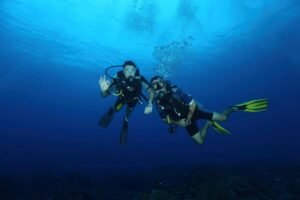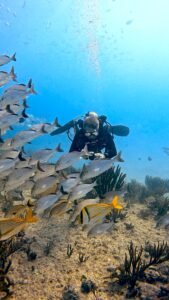Welcome, fellow diving enthusiasts! Whether you’re an experienced diver or just dipping your toes into the underwater world, understanding the language of scuba diving is essential for a safe and enjoyable experience. Welcome to the ABCs of Diving, where we will explore different scuba diving terms as we go through the alphabet. To read previous posts from this column check out our other blogs. Today we continue with the letters E, F and G:

EAN (Enriched Air Nitrox): Enriched Air Nitrox, commonly referred to as EAN or Nitrox, is a breathing gas mix with a higher oxygen content than standard compressed air. It allows divers to extend their no-decompression limits and dive for longer periods of time.
Equalization: Equalization is the process of balancing pressure between the middle ear and sinuses with the surrounding water pressure during descent. Techniques such as swallowing, yawning, or using the Valsalva maneuver help equalize pressure and prevent discomfort or injury to the ears.
Exposure Suit: An exposure suit, such as a wetsuit or drysuit, provides thermal insulation and protects divers from the cold water temperatures encountered during dives. Wetsuits are made from neoprene and allow a thin layer of water to warm against the body, while dry suits keep the diver dry by sealing out water entirely.
First Stage: The first stage is part of a scuba regulator that reduces the high-pressure air from the tank to an intermediate pressure suitable for the second stage (demand valve). It also supplies air to the diver’s alternate air source and inflation devices.
Fogging: Fogging occurs when the inside of a dive mask becomes misty due to condensation caused by differences in temperature between the diver’s face and the water. Anti-fog solutions or defogging techniques help maintain clear visibility during dives.
Freediving: Freediving involves diving underwater without the use of breathing apparatus, relying solely on breath-holding techniques. Freedivers explore depths and interact with marine life using specialized training for breath-holding and safety protocols.

Free Flow: Free flow happens when a scuba regulator delivers air uncontrollably, typically due to malfunctions or adjustments outside the recommended settings. Divers must manage free flows to conserve air supply and ensure safety during the dive.
Gas Embolism: A gas embolism occurs when air bubbles enter the bloodstream, often through rapid ascent without proper decompression. It can lead to blockages in blood vessels, causing serious injury or death if not treated promptly with recompression therapy.
Giant Stride Entry: A giant stride entry is a technique used by divers to enter the water from a boat or platform. Divers stand at the edge, facing outward, and take a large step forward while maintaining balance and control. This entry method minimizes the impact on the water’s surface and is commonly used in open water diving.
Scuba diving is a blend of technical skill, environmental awareness, and appreciation for marine life. By familiarizing yourself with these diving terms, you’ll enhance your diving knowledge and safety practices, ensuring each underwater adventure is a memorable and enjoyable experience. Whether you’re exploring reefs, wrecks, or underwate


